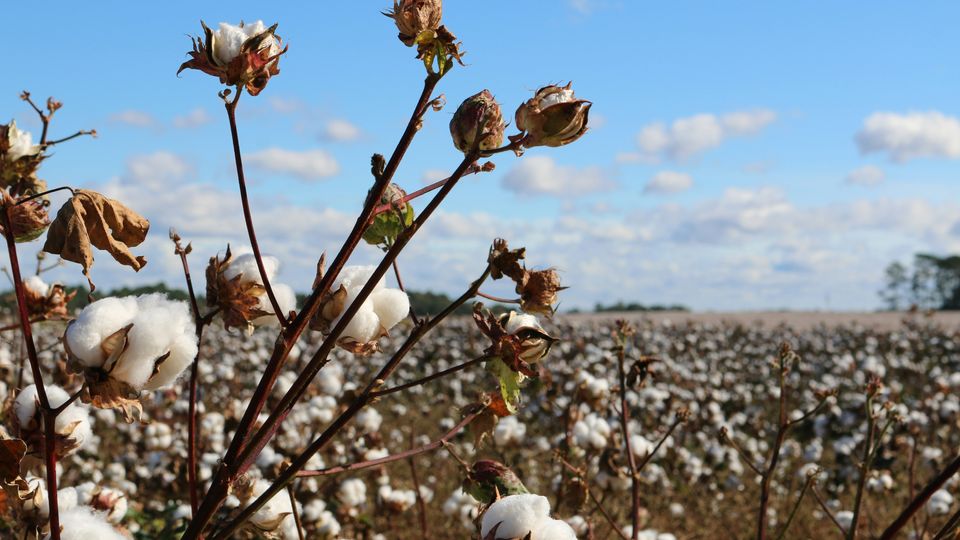A “Green” Alternative to PFAS-Containing Fabric Finishing Agents
Cottonseed oil may be a safer alternative to PFAS-based waterproofing agents for fabric.

Each year, more than 7.5 million bales of cotton are produced in the United States. More than half of this output will be used by the clothing manufacturing industry – spinning cotton into yarn that can be woven into a durable, breathable fabric suitable for all-season wear. But before this fabric can be turned into wearable clothing, it is often subjected to different finishing agents to improve its physical properties.
To create a more water-resistant material, manufacturers will often apply a water-repellent finish that turns the exterior layer of cotton into a hydrophobic surface. These coatings commonly contain per- and polyfluoroalkyl substances (PFAS) – also known as “forever chemicals” – which have been linked to numerous adverse health outcomes and environmental concerns.
In search of alternative techniques for fabric finishing, researchers at North Carolina State University have developed a new method that relies on cottonseed oil as its main feedstock. When treated with their modified cottonseed oil agent, cotton fabric samples demonstrated excellent water repellency without the need for PFAS. Their research was presented at the American Chemical Society’s fall meeting, ACS Fall 2025.
To learn more about fabric finishing and how cottonseed oil may represent a safer, greener future for the industry, Technology Networks spoke with Taylor Kanipe, a graduate student at North Carolina State University, who presented the research findings at ACS Fall 2025.
What is fabric finishing and what methods are currently used for this?
Fabric finishing is the last step in textile manufacturing. Finishing is used to improve the look and feel of fabrics and can also enhance specific performance characteristics. Different types of finishes will impart different properties to fabric. For example, fabric softeners will improve the feel of a fabric and make it softer.
For my research, I am focused on durable press finishes – also called easy-care finishes. Durable press finishes improve the dimensional stability of fabrics and are typically applied to cotton fabrics. These finishes impart wrinkle resistance and prevent shrinking, which cotton is prone to. Additionally, I am studying water-repellent finishes to prevent cotton fabric from absorbing water.
What are the drawbacks of common finishing agents?
Durable press resins can contain formaldehyde. Formaldehyde is classified as a carcinogen and can cause other issues like skin and eye irritation and respiratory issues. While the formaldehyde resins are effective at increasing wrinkle resistance, they pose an exposure risk to those involved in the manufacturing process. Also, as the durable press finishes break down over time, they can release formaldehyde, which can cause different health problems, including contact dermatitis.
Many water repellent and water-resistant coatings are PFAS-based. The persistence of PFAS in the environment and body has been well documented, along with the associated adverse health effects.
Your approach relies on a more natural alternative – cottonseed oil. Can you talk us through how this oil is processed and used for fabric treatment?
For our approach, we start with refined cottonseed oil. This oil then undergoes a simple epoxidation reaction. Using hydrogen peroxide and acetic acid, we are able to place epoxide groups where there were previously double bonds in the oil molecules. After a few cleaning steps, this epoxidized cottonseed oil – we refer to it as ECSO – is ready to use in our fabric treatment process.
The ECSO is dispersed in a solvent with cotton fabric and a Lewis acid catalyst at room temperature. After treatment, any excess oil is removed. We varied some of the treatments to explore the best conditions to improve the performance of the cotton fabric, but the process was the same.
During the treatment, the epoxide groups on the ECSO molecules will covalently bond with hydroxyl groups on the cellulose [found in cotton fibers]. The oil molecules, if multiple epoxide groups react with cellulose, will act as bridges for the cellulose chains. This holds those molecules in place and prevents them from sliding past each other. This improves dimensional stability and increases wrinkle resistance.
To test out this ECSO treatment, you looked at samples of ECSO-treated cotton fabric using a high-speed camera. What did these assessments tell you about the treatment’s performance?
We used a high-speed camera to take photos of water droplets on the surface of the fabric. We then measured the angle between the air, cotton fabric and water ([at the] three phase boundary).
Hydrophilic, or water-loving materials, like our untreated cotton fabric have low contact angles because the water spreads across the fabric surface and is readily absorbed. Hydrophobic materials exhibit water contact angles above 90 degrees. Our ECSO-treated fabrics exhibit high water contact angles, up to 125 degrees, indicating that the surface of the fabric is now repelling water.
Can you speak to the green credentials and benefits of this alternative approach?
“Green” is a hard term to define, but in terms of the process we are using to treat our fabrics, there are a few things that would be considered quite green. We are using a renewable feedstock – cottonseed oil – as the basis for our fabric treatment. These finishes we developed should also be safer than formaldehyde- and PFAS-based finishes, both for manufacturers and for consumers.
Looking forward, what are the next steps for this research?
One of the most important steps in furthering our work is to make our fabric treatment process more environmentally friendly. Currently, our process involves the use of solvents during fabric treatment. Our goal is to develop a water-based treatment process to avoid the use of organic solvents. We are currently exploring the use of oil-in-water emulsions to apply the ECSO to fabrics in water using some common textile finishing equipment.



